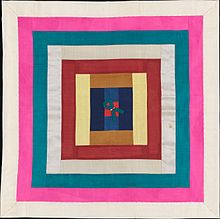Bojagi
| Bojagi | |

Silk patchwork Bojagi from the collection of the Met
|
|
| Korean name | |
|---|---|
| Hangul | 보자기 |
| Hanja | |
| Revised Romanization | bojagi |
| McCune–Reischauer | pojagi |
A bojagi (Hangul: 보자기; MR: pojagi, sometimes shortened to 보; bo; po) is a traditional Korean wrapping cloth. Bojagi are typically square and can be made from a variety of materials, though silk or ramie are common. Embroidered bojagi are known as subo, while patchwork or scrap bojagi are known as chogak bo.
Bojagi have many uses, including as gift wrapping, in weddings, and in Buddhist rites. More recently, they have been recognized as a traditional art form, often featured in museums and inspiring modern reinterpretations.
Traditional Korean folk religions believed that keeping something wrapped protected good luck. It is believed that the earliest use of the wrappings dates to the Three Kingdoms Period, but no examples survive from this period.
The earliest surviving examples, from the early Joseon Dynasty (1392–1910), were used in a Buddhist context, as tablecloths or coverings for sutras. The cloths particularly marked special events, such as weddings or betrothals, where the use of a new cloth was believed to convey "an individual's concern for that which was being wrapped, as well as respect for its recipient." For a royal wedding, up to 1,650 bojagi might be created.
Everyday use of bojagi declined in the 1950s, and they were not treated by Koreans as art objects until the late 1960s. In 1997, the "Korean Beauty" postage stamp series included four stamps featuring bojagi.
Traditionally, the bojagi is a square, measuring from one p'ok in width (approximately 35 cm), for small items, to ten p'ok for larger objects such as bedding. Materials included silk, ramie, and hemp.
...
Wikipedia
